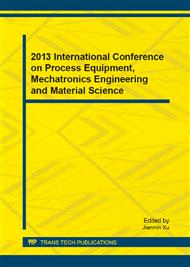p.35
p.39
p.43
p.48
p.52
p.57
p.61
p.65
p.70
Design of an Automatic Cleaning Energy-Saving Technology for Manganese Sulfate Continuous Production Crystallizer
Abstract:
To deal with the high energy consumption of the batch-type single-effect evaporator for Manganese sulfate production, a vibrating-spiral fluidized automatic cleaning technology was developed for continuous crystallizer production. The proposed method is presented followed by validation through a heat transfer coefficient comparison experiment. The result has shown that the proposed method has strong capability of automatic cleaning of crystalline scale. When the flow velocity in tubes is 0.80 m/s and the heat transfer temperature difference is 17°C, the overall heat transfer coefficient can reach 90% of that of clean tubes without spiral-fluidization. Furthermore, it is ideal to keep the volumetric concentration of fluidization particles at 1% and the automatic cleaning capability is almost directly proportional to the flow velocity. The automatic-cleaning continuous-production crystallizer technology can effectively replace the atmospheric-pressure single-effect evaporator and reduce the energy consumption by 95%. Comparing to the three-effect evaporator, the proposed method can save energy up to 88%.
Info:
Periodical:
Pages:
52-56
Citation:
Online since:
July 2013
Authors:
Price:
Сopyright:
© 2013 Trans Tech Publications Ltd. All Rights Reserved
Share:
Citation:


